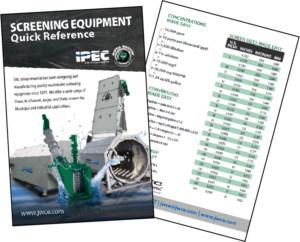
Wastewater Screening Design for Your Wastewater Plant
Wastewater Screening Design Quick Reference Guide
Is your wastewater screening design struggling to meet industry standards? Are you experiencing clogged and damaged equipment on a monthly or even weekly basis? For starters, you should evaluate your preliminary treatment and identify the most effective wastewater screening design for your wastewater plant.
Your screening equipment plays a huge role in your wastewater system as it is the first line of defense to the filtration process. When removing objects such as rags, paper, plastics and metals, screening equipment prevents damage and clogging of downstream equipment.
Determining Specifications and Needs

Wastewater Screen Options
Now that you have calculated the necessary specs, you will need to figure out the appropriate screen for your plant. JWC’s goal is to help you to treat your wastewater efficiently and effectively. JWC has carefully engineered wastewater screening systems for a number of applications that include drum, in-channel, auger and static screens for municipal and industrial placements. With so many choices, what wastewater screening system should you use? Let us break it down for you:
- Rotary Drum Screens are installed in applications that contain flume waters, effluents containing moderate to low solid loadings, high flows or high solids loading zone. These screens are versatile and provide superior solids recovery from waste streams. JWC offers both internally fed drum screens and externally fed drum screens.
- In-Channel Screens are used in situations without a grinder, usually where there is a limited number of rags and no large solids in the waste stream. JWC offers bar screens, chain and rake screens, fine screens and band screens.
- Auger Screens are a robust headworks solution that combines three of JWC’s finest technologies – a grinder, a fine screen and a compactor into one unit called the Auger Monster. This spiral screen removes trash and unwanted solids so the treatment plant runs more efficiently.
- Statics Screens are typically used when the solids are easily separated from the liquid and where the separated solids slide easily. JWC offers Sidehill Static and Sidehill Pressure Screens.
At JWC we offer a wide range of products that target unique challenges with wastewater treatment plants being a top priority. Drum screens, in-channel screens, auger screens and static screens are all used in municipal and industrial applications. The steps are simple, calculate your specs and choose your screen!
Get your Quick Reference Guide now! Click HERE to download.
Wastewater Screen Size Quick Reference
| U.S. MESH | INCHES | MICRONS | MM |
|---|---|---|---|
| – | 0.2362 | 6000 | 6 |
| 5 | 0.157 | 4000 | 4 |
| – | 0.1181 | 3000 | 3 |
| 10 | 0.0787 | 2000 | 2 |
| 12 | 0.0661 | 1680 | 1.68 |
| – | 0.0591 | 1500 | 1.5 |
| 14 | 0.0555 | 1410 | 1.41 |
| 16 | 0.0469 | 1190 | 1.19 |
| 18 | 0.0394 | 1000 | 1 |
| 20 | 0.0331 | 841 | 0.84 |
| 25 | 0.028 | 707 | 0.71 |
| 30 | 0.0232 | 595 | 0.59 |
| 35 | 0.0197 | 500 | 0.5 |
| 40 | 0.0165 | 420 | 0.42 |
| 45 | 0.0138 | 354 | 0.35 |
| 50 | 0.0117 | 297 | 0.297 |
| 60 | 0.0098 | 250 | 0.25 |
| 70 | 0.0083 | 210 | 0.21 |
| 80 | 0.007 | 177 | 0.177 |
| 100 | 0.0059 | 149 | 0.149 |
| 120 | 0.0049 | 125 | 0.125 |
| 140 | 0.0041 | 105 | 0.105 |
| 170 | 0.0035 | 88 | 0.088 |
| 200 | 0.0029 | 74 | 0.074 |
| 230 | 0.0024 | 63 | 0.062 |
| 270 | 0.0021 | 53 | 0.053 |
| 325 | 0.0017 | 44 | 0.044 |
| 400 | 0.0015 | 37 | 0.037 |
| 550 | 0.0009 | 25 | 0.025 |
